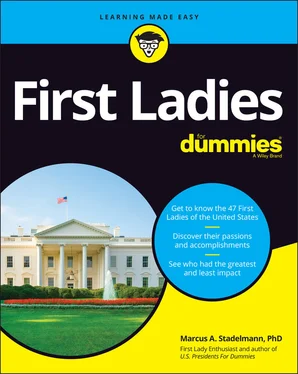 Starting to matter
Starting to matter
 Becoming copresidents
Becoming copresidents
The story of the First Ladies of the United States is one of drama, personal struggle, and both great successes and failures. It’s a story of ambition, joy, disappointment, and most often a total loss of privacy. In the early years of the republic, becoming First Lady imposed considerable dangers, both social and economic, on First Ladies and their families. The White House was open to just about everyone, and it had no security yet.
Today, First Ladies have professional roles and often aid in policy development. They work together with Congress and have become active policy makers. However, every First Lady decides how active they’ll be. Hillary Clinton was one of the most active First Ladies in recent history, while Melania Trump was less active and played the role of a more traditional First Lady (see Chapter 20for more). A First Lady’s temperament, family situation, character, and even relationship with the president determines all of that. First Ladies with big political ambitions can use their office as a stepping stone to future offices. Eleanor Roosevelt did so with working for the United Nations after leaving her role as First Lady in 1945 (see Chapter 14), and Hillary Clinton ran and won a U.S. Senate seat after serving two terms as First Lady (see Chapter 18).
The role of First Lady has seen significant changes over the years. Women have made progress in society and are found at the highest levels of government, including now the vice presidency. Women today serve in Congress, even becoming the Speaker of the House of Representatives; they are members of the Supreme Court; and they govern states. It’s only a question of time before a woman will become president and the U.S. will have its first “First Gentleman.”
First Ladies in U.S. History
Why become a First Lady? Most of the time, First Ladies had no choice. They were married to someone who just became president. In some instances, they had actually pushed their husbands into politics. Great examples include Sarah Polk and Helen Taft (see Chapters 7and 12). They loved the game of politics and enjoyed the prestige of being First Lady. In fact, Julia Grant was so upset that her husband refused to run for a third term that she was in tears when she had to leave the White House ( Chapter 10). More recently, First Ladies wanted to impact social and economic reforms and change the country and its people. Eleanor Roosevelt, Rosalynn Carter, Barbara Bush, and Hillary Clinton are examples of socially conscious First Ladies who wanted to bring about change (see Chapters 14, 17, and 18for more on their stories).
Most of the 47 First Ladies in this book are famous because of the men they married. However, most First Ladies also impacted their husband’s lives and directly and indirectly made significant contributions to U.S. history. From Martha Washington ( Chapter 3) traveling with the Continental Army and improving soldiers’ morale to Mary Todd Lincoln ( Chapter 9) encouraging her husband to run for political office, in turn saving the Union, to Helen Taft ( Chapter 12) pushing her husband to become president, American history wouldn’t have been the same without the country’s First Ladies.
Until recently, it was believed that First Ladies mattered and held their jobs only because their husbands had become president. That is true by definition but doesn’t explain the whole story. Many claim that First Ladies owe their space in history to the men they married and that they didn’t contribute much to the history and evolution of the United States. For them, First Ladies were basically footnotes in history. This is clearly wrong.
FINANCIAL RAMIFICATIONS OF BEING FIRST LADY
Early on, the positions of President and First Lady imposed financial hardships. Presidents and First Ladies had to use their own resources to furnish the White House and to host dinners and parties. The amount of money Congress appropriated for these functions wasn’t enough, and to top it off, the job of president wasn’t compensated well, and the First Lady received no compensation at all. And, of course, after retirement, neither the president nor First Lady received a pension. This would not change until pensions for ex-presidents were approved in the 1950s, and presidents started receiving a comfortable salary beginning in 1969, when President Nixon received salary of $200,000.
Therefore, the job of First Lady involved personal sacrifices, and often a price, usually economic or even health-wise, had to be paid. Unlike today, when presidents and their wives make millions after they retire, usually by writing their memoirs and/or giving speeches, back then, being president could bankrupt a family. Early presidents and First Ladies left the White House often poorer than when they entered it. Dolley Madison, for example, was broke at the end of her life, and people left money in her house whenever she invited them over.
Not surprisingly, many First Ladies were quite upset when they found out their husbands had won the presidential elections and didn’t celebrate but withdrew from the functions expected of a First Lady. Instead, they had their daughters or nieces take their place. Other First Ladies, like Sarah Polk, became penny pinchers and tried to run the White House the cheapest way possible.
Studies show that many First Ladies mattered more than people thought. They helped out with finances, managing family farms, teaching school, or working after getting married so that their husband could enter politics. In addition, most First Ladies came from social and economic backgrounds superior to the men they married. Without their contributions, their husbands couldn’t have become presidents. Many First Ladies were even familiar with politics and had early exposure to politics through a father, a grandfather, or an uncle. Helen Taft, for example, decided to pursue a career in politics through her husband. Her father and grandfather had served in Congress, and she enjoyed the campaign for political office. This allowed her to give advice and help advance her husband’s political career. Without her, there would have been no President Taft. (See Chapter 12for her full story.)
It took quite some time to discover how important First Ladies actually were in the history of the U.S. The reason is that most early First Ladies, such as Martha Washington, didn’t leave a lot of information for historians to study. Many burned all their correspondence with their husbands and friends that contained much information. The few who didn’t, like Abigail Adams, left historians with a plethora of information and provided a picture of the time they lived in and information on their job as First Lady and how they contributed to their husband’s career and successes.
This started to change, however, after the Civil War. First Ladies started leaving more information to be studied. In fact, Julia Grant, Helen Taft, and Edith Wilson all wrote their memoirs, giving us a lot of information on the role of First Lady and the gradual changes the office undertook.
Most First Ladies accomplished great things, often before becoming First Lady. Here are some examples:
Elizabeth Monroe single-handedly saved the wife of the American war hero the Marquis de Lafayette in Paris during the French Revolution. See Chapter 5.
Louisa Adams traveled by herself with a young child during the wintertime from Russia to France during the Napoleonic wars. See Chapter 5.
Читать дальше

 Starting to matter
Starting to matter










